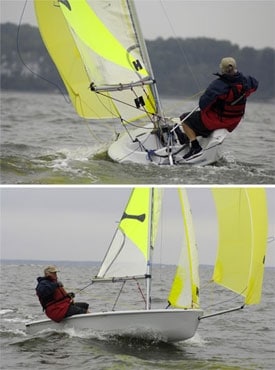
RS Feva
The RS Feva was originally introduced in England in 2003, and more than 900 boats have been sold to date. Fleets have been established in England and many European countries that sail. This 12-foot performance dinghy features a rotomolded (rotational molding process) hull and is imported and sold in the United States by Vanguard Sailboats, of Rhode Island. Upon our initial inspection, my first concern was the use of this low-cost manufacturing technique for a high-performance dinghy where stiffness is a basic requirement. The material used for this process is typically a high-density polyethylene, which has very good dent, scratch, and crack resistance, but is low on the stiffness scale.Thus it was a pleasant surprise to find that in gusty 10 to 25 knots of wind, our test sail proved that this 12-foot, rotomolded hull was adequately stiff and strong for serious loads. It’s this boatbuilders opinion that Roto Mold Technology has come a long way in recent years, and with good design the RS Feva hull should have a good lifespan. The RS Feva was originally designed by Paul Handley as a youth trainer for children in the 11-14 age group. We sailed the Feva first with one adult and then with two adults to see how capable this little package was in the gusty heavy air that prevailed. The result was that this supposed child’s dinghy was in reality a little rocketship that easily planed under the weight of two adults-about 320 pounds total-achieving burst of speeds in the mid teens, and handling the 2- to 3- foot waves with ease.The 135-pound Feva hull has the shape of a scaled down 49er, with a flat planing bottom running well aft. There are several runner-type strakes that stiffen this flat area and provide added protection for beaching and haulout. The deck/cockpit structure is clean and simple with little to bang shins or knees. The cockpit floor slopes aft to an open transom, so that it drains immediately. The most clever and impressive feature is a strong, stiff thwart attachment that supports a freestanding mast that can be sailed without stays with only the 69 sq. ft. main. It’s only when the 22 sq. ft. jib and the 73 sq. ft. gennaker are added that side stays and a forestay are added (there’s a rope luff in the jib) to take the extra load. This thwart also functions as the enclosure for launching the single-line pole and gennaker. The jib tacks at the top of the snuffer orifice so that the takedown of the gennaker is easily accomplished on either tack by pulling the continuous “hoist/douse” line, as is done on 49ers.The 15-foot mast is an aluminum two-piece extrusion made by Selden with an integrated sail track. The mast joint is angled and looks to be well designed. The 6-foot boom is fitted with a three-to-one vang that appeared to be adequate for the 68 square foot mainsail. The two-to-one purchase on the main may be a little under-specced for a younger youth sailor. I would judge the daggerboard to be larger than normal for the sail area. Both it and the rudder appeared to be sophisticated foil sections. When sailed flat the Feva tracked well to weather with a nice feel to the helm. The Feva does not have a trapeze, but the 56-inch beam, together with a comfortable hiking platform and hiking straps made it easy and comfortable to hike out. The dinghy sailor on our judging team, Chuck Allen, was able to single hand the Feva to weather in gusty stuff, but a little more weight seemed better and two adults handled the Feva in these conditions with ease. With the hull pre-rigged with righting lines, our capsize test showed the Feva to be a cinch both to right and re-center. The best part about the Feva is its price of $4,995; it has to be one of the better bangs for the buck for a performance trainer. For this price there doesn’t seem to be any skimping on this boat. All the sails (Hyde) seem well made and shapely. The hardware is all Holt and Wichard throughout.All the judges felt the RS Feva has the potential to have a significant impact on youth sailing; it’s fun, affordable, and practical. It has already become extremely popular in Europe and has the makings of becoming a one-design class with international standing.This 150-pound, reasonably fit senior citizen looks at the RS Feva as a fun boat that one could handle and sail well into old age. Thus, the Feva, originally designed for children, might be just the ticket for us aging seniors who still want a little excitement in the boats we sail. I’m giving serious thought to ordering one. Vanguard Sailboats.Meade Gougeon and his brother Jan are the Gougeon Brothers, who invented and manufacture West System Epoxy.









